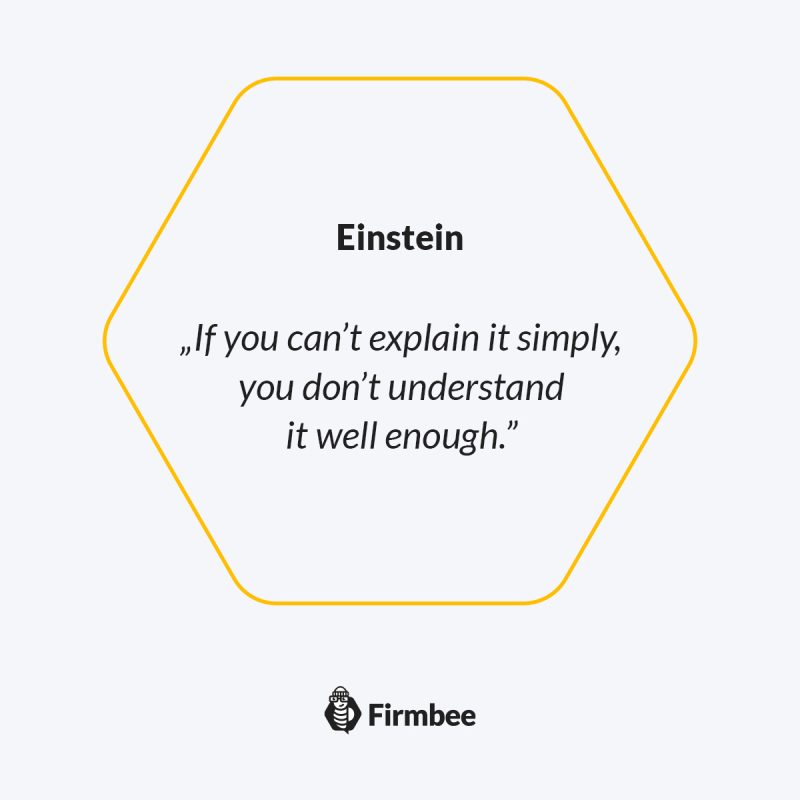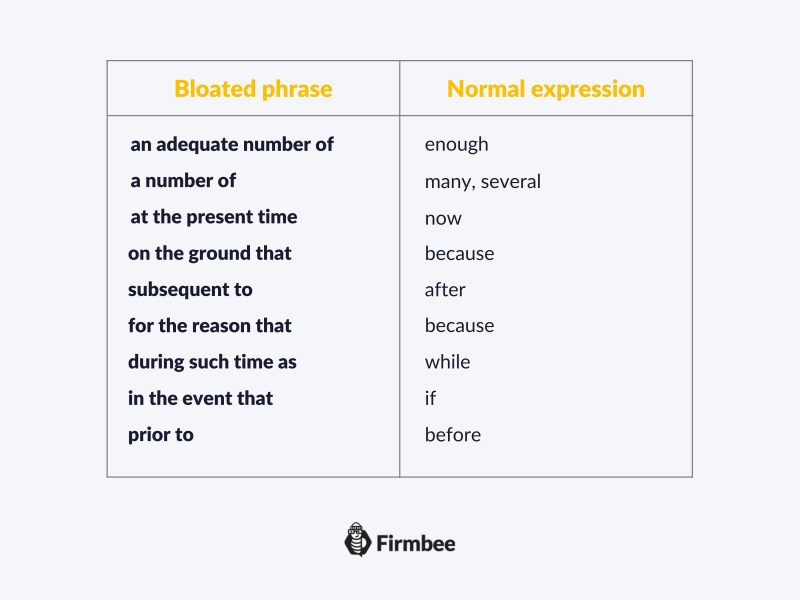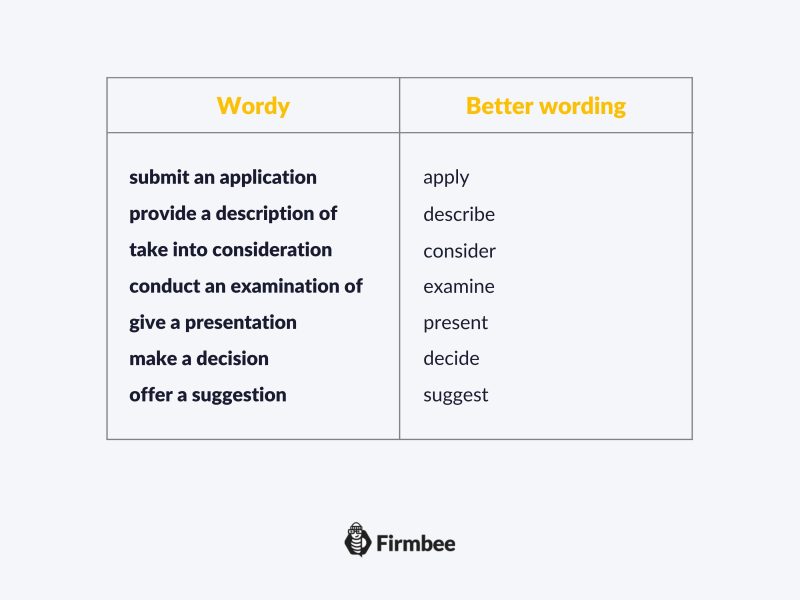What is plain language? This expression certainly shouldn’t evoke any negative connotations. Actually, plain English is interesting and pleasant to read. Although it’s direct, straightforward, and well-organized, it can still express complex ideas. When using plain language, you make your content concise and accessible to a wider audience. There are plenty of techniques that might help you achieve this. If you’re writing for the web, consider using the following tips. Let’s dive in!
What is plain language? – table of contents:
- Combat verbosity
- Avoid sophisticated words
- Use short sentences and paragraphs
- Put the subject and verb at the beginning
- Write parallel sentences
- Minimize passive voice
- Forget about is, are, was and were
- Watch out for of and wordy phrases
- Turn nouns into verbs
- Shun acronyms
- Use a conversational tone
- Introduce each paragraph with a topic sentence
- Build bridges
- Structure your content
- Summary
Combat verbosity
If the sentence is too long, its basic point tends to get lost. Cut to its essence, the thought itself seems more concise. While it is easy to turn a 15-word sentence into a 20-word sentence, reversing this process is a rare art. Tighten your content, but keep it natural and idiomatic. Get rid of unnecessary words, but never delete the ones whose omission might confuse the reader.
Avoid sophisticated words
When you write, think about how to convey your thoughts with the simplest words possible. Ideally, imagine that you are explaining something to a child or an elderly person. If you can describe a topic in such a way that a kid can understand it, it is likely that everyone will. Obviously, it’s not about using infantile language or assuming that the reader is stupid. It’s about empathy and understanding that everyone sometimes has worse moments.

Use short sentences and paragraphs
Your average sentence length determines the readability of your writing. Therefore, you should have some 30-word sentences and some 10-word sentences. Just monitor the average, and keep it to about 20 words. If you want to achieve a clear and readable style, don’t try to say too many things at the same time, with too much detail and too little relevance. Also, break long paragraphs up. This simple technique will improve legibility and generate both speed and interest.
Put the subject and verb at the beginning
The English language follows the subject-verb-object order rather strictly. Sentences are better understood if the subject and the predicate are close together at the beginning of the sentence. Add clarity to your style by following this simple rule. This will help readers understand what you are talking about, and will make it easier for them to follow your thoughts when they read your content.
Write parallel sentences
Many grammatical structures require parallelism. The most common correlative conjunctions are as follows:
- Both…and
- Either…or
- Neither…nor
- Not only…but also
Putting words in pairs will make your sentences clearer and easier to understand. Using the same pattern of words also indicates that two or more ideas are equally important.
Example 1
Not Parallel:
Michael loves dancing, climbing, and to ride a bike.Parallel:
Michael loves dancing, climbing, and cycling.Example 2
Not Parallel:
Michael loves dancing, climbing, and to ride a bike.Parallel:
Michael loves dancing, climbing, and cycling.Example 3
Not parallel: The student was asked to write his essay clearly, accurately, and in a detailed manner.
Parallel: The student was asked to write his essay clearly, accurately, and thoroughly.
Always remember to skim your text to check if any sentences need to be made parallel.

Minimize passive voice
The active voice is basically better than the passive voice since it requires fewer words, and thus makes the reading easier and faster. The passive voice, in turn, is wordy and complicated. Consider these two examples:
- They were painting the fence when I arrived.
- The fence was being painted when I arrived.
The second sentence feels academic, formal, and stuffy. Therefore, you shouldn’t use the passive voice in more than 10% of your text. Always scan your content in search of passive sentences, and then try to change them into active ones, if possible.
Forget about is, are, was and were.
Highlight every is, are, was, and were, and check whether you can improve your text by removing them. Many writers wrongly believe that a be-verb always indicates a passive voice. In fact, it’s only some part of the passive voice structure. Nevertheless, even if be-verbs don’t always make sentences passive, they can certainly weaken your prose. By reducing the number of them, you can enliven your text considerably. Let’s take a closer look at the following sentences:
- Jones is in agreement with Smith.
- Jones agrees with Smith
The second sentence sounds way better than the first one. Always try to use strong and precise verbs in your writing.
Watch out for of and wordy phrases
Focus on each of to check whether it’s forming a wordy phrase. You might be surprised how often it happens. Reducing the ofs by 50% or so can greatly improve speed and readability. Also, replacing bloated expressions with everyday words might help a lot. Take a look at the following list.

Improve your style by shortening your sentences, phrase by phrase.
Turn nouns into verbs.
It’s not just passive voice and be-verbs that can weaken your prose. So can abstract nouns made from verbs. Avoid using words ending in -ion when it is possible. Write that something illustrates something else, not that it provides an illustration of it. Take a deeper look at more examples:

Shun acronyms
If you would like to gain a lot of readers, make sure you understand the acronyms you use, and that you know for sure what they are saying. Jargon and acronyms can obscure your prose. Therefore, when using abbreviations, always remember to explain them. For example:
- RWD (Responsive Web Design)
- CTA (Call to Action)
- CRO (Conversion Rate Optimization)
- CSO (Chief Security Officer)
Use a conversational tone
Whenever you write, the best approach is to be relaxed and sound natural. That tone communicates confidence. It shows that you are comfortable with your written voice. A relaxed tone can be achieved through contractions and pronouns. Make everything you write speakable, and address your reader directly.
Introduce each paragraph with a topic sentence
Think about the subject matter of your writing and start each of your paragraphs with a topic sentence. It should express the main idea of the given passage of text and set its tone. Based on a properly written topic sentence, your readers will be able to predict what they can expect from the rest of the paragraph, e.g., figure out if the paragraph will contain a list, statistics, a narrative, or something else.
Build bridges
Bridge between your paragraphs. It’s not about a sentence started in one paragraph having its continuation in the next paragraph. Nor is it about linking the last sentence of a paragraph to the first sentence of the next paragraph. And even less about repeating a sentence literally. It is rather about connecting ideas with each other to make a unified whole.
Structure your content
Divide your content into visible parts. Doing so will help you and your readers. The more complex your project is, the simpler and more overt its structure should be. In fact, headings have many benefits:
- They help you organize your thoughts.
- They let readers know where they are at a glance.
- They make your text visually attractive.
- They make the text skimmable.
- They instantly signal transitions and add cohesion to your writing.
- When put into a table of contents, they serve as an overview of the whole document.
Use informative headings, bullets, and highlights. These are signs that help readers know where they are currently and where what they are looking for. Experts at Nielsen Norman Group say it clearly: people read only 20-28% of the text on a webpage. They merely scan the rest. If you take care of the structure and make it easy for your audience to read selectively, they’ll still pull out what’s most important. And if they want more, they’ll definitely know where to come back.
Summary
Bloated expressions that displace everyday words are mostly unreadable. Therefore, when creating content, you shouldn’t blindly adopt the worn-out, ineffective writing habits of the past. Embrace simplicity instead. Learn to write clearly. Writing is like any other skill, so it can be improved.
If you want to write well, you can’t sound like a machine. You need to learn to sound like yourself. Use a conversational tone and write as you talk. Plain language should be the foundation of any piece of writing, but it is easy to fall into various traps and unknowingly complicate the message.
You’ve just learned the answer to the question: What is plain language? Want more advice on clear writing? Check out the following article: Web writing principles – how to write for the internet?
If you like our content, join our busy bees community on Facebook, Twitter, LinkedIn, Instagram, YouTube, Pinterest.
Author: Kamil Jasiński
A SEO Specialist In love with words. Constantly surprising others with ways to use them for one's advantage. Wake her up in the middle of the night, and she’ll start discussing her latest SEO positioning idea with you.


















